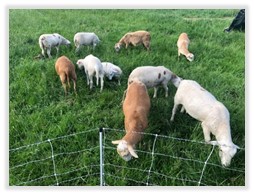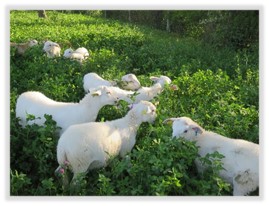 Weaning lambs on a small farm can be a challenging endeavor. Being limited on space and supplies, such as electric fencing, means careful planning must take place to manage the two groups separately. There are various ways to wean lambs off of their dams. The approach you choose may vary from year to year depending on the mix of ewe and ram lambs per dam, the ages of the lambs, changes in the size of the flock, available resources and even the weather.
Weaning lambs on a small farm can be a challenging endeavor. Being limited on space and supplies, such as electric fencing, means careful planning must take place to manage the two groups separately. There are various ways to wean lambs off of their dams. The approach you choose may vary from year to year depending on the mix of ewe and ram lambs per dam, the ages of the lambs, changes in the size of the flock, available resources and even the weather.
Some folks choose to fence line wean by dividing the groups with fencing (preferably permanent) and moving the two groups apart over time. This could prove to be “messy” if you don’t have adequate fencing to divide them. Weaning “cold turkey” might be the best option as it is relatively brief and simple. With the cold turkey method, it is essential to monitor your ewes’ udders throughout the process to identify any issues leading to mastitis. Keeping the lambs with the ewes and allowing them to self-wean appeals to some, but only works if the ram lambs have been wethered. Some  farmers choose to wean in a hybridized fashion where ram lambs are separated and then ewe lambs are kept on the dam to wean off naturally. This could be less desirable as some ewes may never really recover from raising their lambs before rebreeding (i.e., those with twin ewe lambs) while others may become over conditioned (those with single ram lambs). The upside to the hybrid weaning method is only having to manage one group of animals if ram lambs are sent off to the sale barn. It’s important to separate intact ram lambs from mature ewes by the time they’re four months old, and from ewe lambs by five months to avoid accidental breeding.
farmers choose to wean in a hybridized fashion where ram lambs are separated and then ewe lambs are kept on the dam to wean off naturally. This could be less desirable as some ewes may never really recover from raising their lambs before rebreeding (i.e., those with twin ewe lambs) while others may become over conditioned (those with single ram lambs). The upside to the hybrid weaning method is only having to manage one group of animals if ram lambs are sent off to the sale barn. It’s important to separate intact ram lambs from mature ewes by the time they’re four months old, and from ewe lambs by five months to avoid accidental breeding.
Whichever method you choose there are several factors to consider before weaning day. With limited grazing areas, plan ahead by designating your best fields for your lambs. Plan for your ewes to be on the poorest quality field with fencing very hot as they will be very hungry and eager to breach the fence. Physical barriers are extremely helpful in keeping both groups calm. Ensuring that the ewes and lambs cannot see each other is very important. Tree lines, buildings, even a large tarp or shade cloth hung to act as a wall can provide adequate visual dividers. On a small holding, preventing them from hearing each other is probably impossible, so just reduce all other stressors as much as possible. There is also the option of sticking the ewes in the barn (if you have one) or dry lot area on the lowest quality hay available until they have dried off. Ration them tightly and trust that they will eat every stem. It may be easier to monitor the udders this way versus in the field. After you have managed to split the two groups and they stop crying to each other, usually after a couple days, the thick of it has passed.
 Now that you have two groups, you must manage them. On small land, fencing and adequate forage are probably your most challenging factors. With two groups you must have two “sets” of everything: buckets, mineral feeders, fencing, energizers, shelters, etc. Keeping your stocking density at a practical level that accommodates ewes and their lambs is essential to prevent overgrazing. Keep dry ewes on your poorest fields as they do not need excessive, high-quality forage to maintain their condition. Lambs can be kept on your highest quality fields to keep up with their growth. You may also graze your lambs on fresh sections and then after you move them along, follow them with your dry ewes. This allows the lambs to graze the best forage first with the ewes following to clean up. This is convenient as it keeps all of the sheep and supplies in the same general area of your property. After 6 to 8 weeks, you could try to put ewe lambs back with their mothers and then manage your ram lambs separately. Some alternatives to managing a group of ram lambs would be to wether them and keep them with your ewes or to sell them off.
Now that you have two groups, you must manage them. On small land, fencing and adequate forage are probably your most challenging factors. With two groups you must have two “sets” of everything: buckets, mineral feeders, fencing, energizers, shelters, etc. Keeping your stocking density at a practical level that accommodates ewes and their lambs is essential to prevent overgrazing. Keep dry ewes on your poorest fields as they do not need excessive, high-quality forage to maintain their condition. Lambs can be kept on your highest quality fields to keep up with their growth. You may also graze your lambs on fresh sections and then after you move them along, follow them with your dry ewes. This allows the lambs to graze the best forage first with the ewes following to clean up. This is convenient as it keeps all of the sheep and supplies in the same general area of your property. After 6 to 8 weeks, you could try to put ewe lambs back with their mothers and then manage your ram lambs separately. Some alternatives to managing a group of ram lambs would be to wether them and keep them with your ewes or to sell them off.
Oftentimes with small farms and homesteading, self-reliant meat production is central to your sheep operation. Keep this in mind when planning your weaning strategy. It will shape how and when you wean your lambs. Keeping a hearty group of ram lambs until they grow out is a sensible option if a well thought out management strategy is in place from weaning time to your butcher date. You must be able to keep them securely separated from your ewes, especially if you plan to keep them into the fall. If this is too difficult or impractical, wethering is probably the best option for your table lambs.
Having a strategic plan in place before weaning is critical to your success and to avoiding hiccups along the way. Inventory your equipment, map out your fields, and secure a contingency plan. It may take some experimentation on your farm with your management to perfect weaning.
By: Allison Rudd, Oxberry Farm
EAPK Member
![]()


